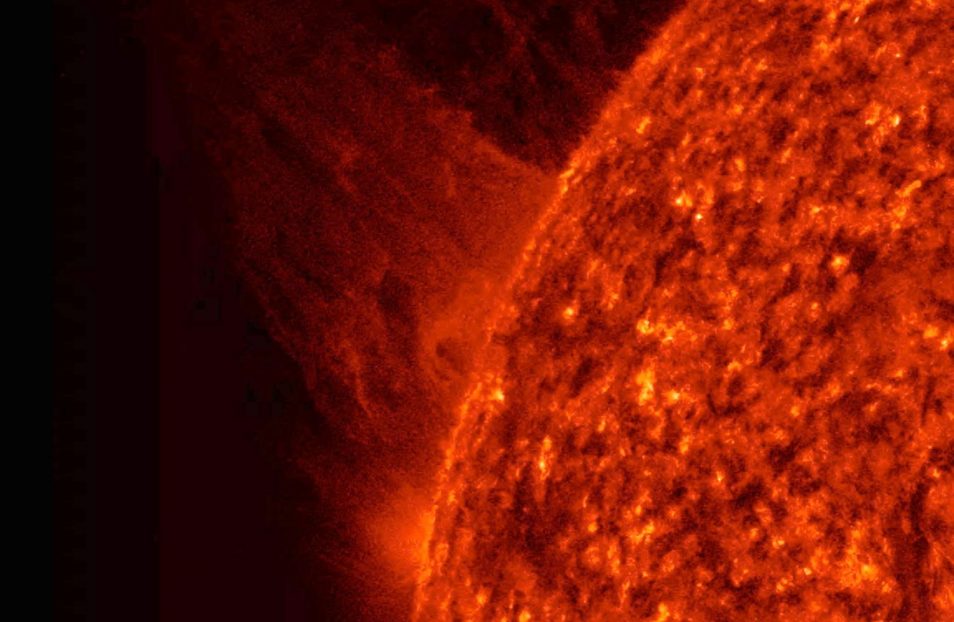
A sheet of plasma blasting out into space from just behind the edge of the sun. Credit: NASA/GSFC/Solar Dynamics Observatory
Space is whack. On Titan (one of Saturn’s moons) it rains methane; on exoplanet Kepler-13Ab it snows sunscreen (but only on the permanently freezing cold side); on the Sun we have plasma tornadoes. You can’t make this stuff up. No wonder people loved the chance to ask astronomers their burning space questions. As a part of ABCs Stargazing Live program earlier this year, our astronomers answered viewer’s burning space questions on Twitter.
Here’s what they said:
Question:
James Ramsey @JamesRoute96
#StargazingABC When will we see a supernova in our galaxy? And would it be really bright?
Answer:
Hi James, the last supernova seen by unaided eyes in our galaxy was Kepler’s supernova in 1604 so we are overdue for another one on most estimates. Supernova 1987A in the Large Magellanic Cloud, one of our satellite galaxies. #stargazingABC
Question:
Jack Brady @jackb184
@ProfBrianCox could a quantum theory of gravity be proved by observing binary pulsars? Jack Brady age 16 #StargazingABC
Answer:
Binary pulsar systems provide some of the most stringent tests of General Relativity – so far it has passed them all #StargazingABC
Question:
Jason Clarey @jaseclarey
Hi Prof Brian. My question is can we presently only detect exoplanets which pass in front of their parent star? If so that must mean many many more are hidden from us due to their orbital plane not being favourable to us when viewing them?#StargazingABC
Answer:
There are a few other techniques astronomers use to detect exoplanets. A very massive planet will have a strong gravitational pull on the star. In effect, the star is moving away and towards us, as the planet orbits the star. We can detect that pull on the star via the Doppler effect. Pulsars are neutron stars that give off a regular pulse of radio light. The orbit of a planet around such a star can change the time of that pulse, and this was one of the first ways exoplanets were found!
Question:
★ Jill Clarke ★ @jayc456
@ABCTV #StargazingABC – how are the neutrino’s formed in our sun, and how do we detect them, streaming by the billions, through us on the Earth? @ProfBrianCox @julia_zemiro @timminchin
Answer:
Hi Jill, we have more details on how neutrinos are produced inside the Sun here: atnf.csiro.au/outreach//educ… Neutrino observatories include Super Kamiokande in Japan and IceCube in Antarctica. #StargazingABC
Question:
Jason Lumsden @SkwotnDungBeetl
As we are all made of star stuff, where was the star that our stuff comes from? #StargazingABC
Answer:
Hi Jason, the material, hydrogen and helium that stars are made from was formed in the Big Bang
Question:
Lisa Beatty @Lisa_Beatty
Will (age 7) is loving #StargazingABC and wants to know how Saturn’s rings are made? Awesome show!
Answer:
We think Saturn’s rings formed when one or more of its moons broke up in orbit, due to Saturn’s very strong gravity. Or it captured and broke up comets and asteroids. The pieces kept colliding with each other and broke into even smaller pieces, until they became rings.
Question:
Lachlan Harris @lachie_harris12
#StargazingABC How long does it take for a star to form?
Answer:
Hi Lachlan, a massive star, 15 times mass of our Sun takes about 100,000 years for the cloud of gas to collapse under gravity and become a star. Strs like our Sun take longer, about 50 million years. #StargazingABC
Question:
Lauren Lester @lozenge_lester
#StargazingABC My question as a grade 8 “scientist”- How do stars get their energy? Can you explain? @ProfBrianCox @julia_zemiro
Answer:
Stars such as our Sun get their energy through hydrogen nuclei fusing together in the core, eventually producing helium and releasing energy. matter is converted into energy.
Question:
KO @koinau
How much would a 100kg human weigh on all the different planets? #StargazingABC
Answer:
The Exploratorium science museum in San Francisco has a handy online calculator where you can calculate your weight on each planet: exploratorium.edu/ronh/weight/


25th May 2018 at 4:14 pm
Hi very interesting edition. I’ve withdrawn from social media, so no twitter. That statef I’d like to see an article on the following question in the future. I think we can all agree that the stuff we stand on is made up of elements created at the big bang. That stated, how can some astronomers be claiming that they are observing light from the big bang? For to do that they would have to have the ability to look in the direction of the big bang look past that location and have the ability to catch up to that light moving at the speed of light to observe it, impossible yes? Or alternatively, turn their equipment in exactly the opposite direction of the big bang location catch up to the big bang light again moving at the speed of light and observe it again impossible yes? Please explain.